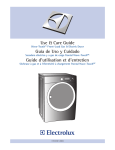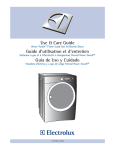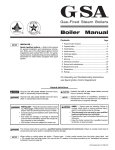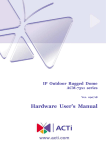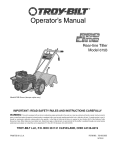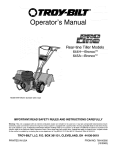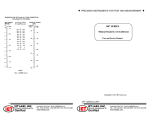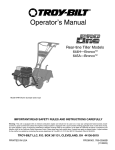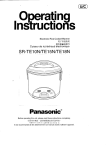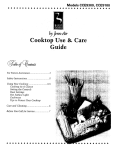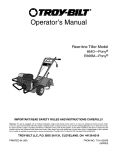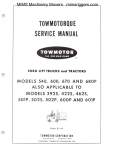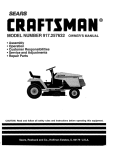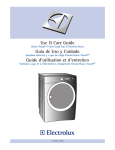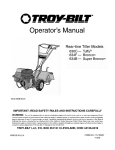Download Troy-Bilt 1634A Tiller User Manual
Transcript
® O m m 'W//////aI&_AIIIIIIIIIIIIIF / m mllllllllllllllllml m Operator's Manual Rear-tine Tiller Models 630C--Tuffy 634AmSuper Bronco TM Mode1634A Shown IMPORTANT: Warning: Read safety rules and instructions This unit is equipped with an internal combustion carefully before operating engine and should not be used on or near any unimproved equipment. forest-covered, brush- covered or grass-covered land unless the engine's exhaust system is equipped with a spark attester meeting applicable local or state any). If a spark arrester is used, it should be maintained in effective working order by the operator. In the State of California the above is by law (Section 4442 of the California Public Resources Code). Other states may have similar laws. Federal laws apply on federal lands. arrester for the muffler is available through your nearest engine authorized service dealer or contact the service department, P.O. Box Cleveland, Ohio 44136-0019. laws (if required A spark 361131 Troy-Bilt LLC, P.O. BOX361131CLEVELAND,OHIO44136-0019 PRINTEDIN U.S.A. FORMNO. 770-10594E 9/9/04 TABLEOFCONTENTS Content Customer Support Safety Assembly Features and Controls Page 2 3 6 10 Operation 12 Content Maintenance Off-season Storage Troubleshooting Parts List Page 17 21 22 23 Warranty Back Cover FINDINGMODELNUMBER This Operator's Manual is an important part of your new lawn tractor. It will help you assemble, prepare and maintain the unit for best performance. Please read and understand what it says. Before you start assembling your new equipment, please locate the model plate on the equipment and copy the information from it in the space provided below. A sample model plate is also given below. You can locate the model plate by looking at the rear of the tine shield. This information will be necessary to use the manufacturer's web site and/or help from the Customer Support Department or an authorized service dealer. Copy the model number here: OTRDV-BILT Copy the serial number here: T,OV-BmLT LLC 361131 P. O. BOX www.troybilt.com CLEVELAND, OH44136 330-558-7220 ,. 1-800-520-552_ CUSTOMER SUPPORT Please do NOTreh/m the l/nit to theretailer withoutfirst contactingCustomerSupport. If you have difficulty assembling this product or have any questions regarding the controls, operation or maintenance of this unit, you can seek help from the experts. Choose from the options below: Visit troy-bilt.com for many useful suggestions. Click on Customer Support button and you will get the four options reproduced here. Click on the appropriate button and help is immediately available. /;/ ,> ..... j;_ ?" #'s ;'V }/ ) f ; F_ * ;,, #FOX }_ " 4t, ' @; i/!s t , j," ;D ,,, >,, _ 7>,,,,,v yO, rL;," ft, '_,-. , ¢j ,_ <# *x J ,_;7 f'_;:' ,7;; _ _tf';_'iv c ,l If you prefer to reach a Customer Support Representative, please call 1(800) 520-5520. The engine manufacturer is responsible for all engine-related issues with regard to performance, power-rating, specifications, warranty and service. Please refer to the engine manufacturer's Owner's/Operator's Manual, packed separately with your unit, for more information. SECTION1: SAFETY This machine meets voluntary safety standard B71.8-1996, which is sponsored by the Outdoor Power Equipment Institute, Inc., and is published by the American National Standards Institute. ForwardClutchBail ReverseClutchControl (Models634A) WARNING DepthRegulator The engine exhaust from this productcontains chemicals known to the State of California to TineHoodFlap cause cancer, birth defects or other reproduc- SafetyAlert Symbol ,_ in thisis manual the unit Ittoisalert This a safetyand alertonsymbol. used you to potential hazards. When you see this symbol, read and obey the message that follows it. Failure to obey safety messages could result in personal injury or property damage. 1. Carefully readthis OwnTraining er's Manual, the separate Engine Owner's Manual, and any other literature you may receive. Be thoroughly familiar with the controls and the proper use of the tiller and its engine. Know how to stop the unit and disengage the controls quickly. 2. Never allow children to operatethe tiller. Never allow adults to operatethe tiller without proper instruction. 3. Keepthe area of operation clear of all persons, particularly children and pets. 4. Keepin mind that the operator or user is responsible for accidents or hazards occurring to other people,their property,and themselves. Preparation 1. Thoroughly inspect the area where the tiller is to be usedand remove all foreign objects. 2. Be sure all tiller controls are released and both wheels are in the Wheel Drive position before starting the engine. Standard-Rotating-Tines (SRT) Drive Pin Figure 1-1: Tiller features and contre/s. See separate Engine Owner'sManua/ to identify engine contre/s. 3. Donot operatethe tiller without wearing adequateouter garments. Avoid loose garments or jewelry that could get caught in moving parts. 4. Do not operatethe tiller when barefoot or wearing sandals, sneakers,or light footwear.Wear protective footwear that will improve footing on slippery surfaces. e. Replaceall fuel tank and container caps securely. f. If fuel is spilled, do not attempt to start the engine, but move the machine away from the area of spillage and avoid creating any source of ignition until fuel vapors havedissipated. 5. Do not till near underground electric cables, telephone lines, pipes or hoses. If in doubt, contact your telephone or utility company. 7. Never makeadjustments when engine is running (unless recommended by manufacturer). 6. Warning: Handlefuel with care; it is highly flammable and its vapors are explosive. Takethe following precautions: Operation a. Store fuel in containers specifically designed for this purpose. b. Thegas capshall neverbe removedor fueladdedwhiletheengineis running. Allowthe engineto cool for several minutes beforeadding fuel. c. Keepmatches, cigarettes, cigars, pipes, open flames and sparks away from the fuel tank and fuel container. d. Fill fuel tank outdoors with extreme care. Never fill fuel tank indoors. Use a funnel or spout to prevent spillage. 1. Do not put hands or feet near or under rotating parts. 2. Exerciseextreme caution when on or crossing gravel drives, walks, or roads. Stay alert for hidden hazards or traffic. Do not carry passengers. 3. After striking a foreign object, stop the engine, remove the wire from the spark plug wire and prevent it from touching the spark plug. Thoroughly inspect the machine for any damageand repair the damage before restarting and operating the machine. 4.Exercise caution toavoidslipping orfall- If in doubtaboutthe tilling conditions, aling. ways usethe following operating precau5.If theunitshould starttovibrate abnor- tionsto assistyou in maintainingcontrol of the tiller: mally, stoptheengine, disconnect the sparkplugwireandprevent itfromtouch- a. Walk behindand to one side of the tiller, usingone handon the handle ingthesparkplug,andcheck immediately bars Relax yourarm, but use a forthecause. Vibration isgenerally a secure handgrip. warning oftrouble. 6. Stop the engine, disconnect the spark plug wire and prevent it from touching the spark plug, whenever you leavethe operating position, before unclogging the tines, or when making any repairs, adjustments or inspections. 7. Takeall possible precautions when leaving the machine unattended.Stop the engine. Disconnect the spark plug wire and move it away from the spark plug. Besure that both wheels are in the Wheel Drive position. 8. Before cleaning, repairing, or inspecting, stop the engine and make certain all moving parts have stopped. Disconnect the spark plug wire and prevent it from touching the spark plug to prevent accidental starting. 9. The flap on the fine hood must be down when operating the tiller. 10. Never use the tiller unless proper guards, plates, or other safety protective devices are in place. 11. Do not run the engine in an enclosed area. Engineexhaust contains carbon monoxide gas, a deadly poison that is odorless, colorless, and tasteless. 12. Keepchildren and pets away. 13. Never operate the tiller underengine powerif thewheels are in the Freewheel position. In the Freewheelposition, the wheels will not hold the tiller back and the revolving tines could propel the tiller rapidly, possibly causing loss of control. Always engagethe wheels with the wheel drive pins in the Wheel Drive position before starting the engine or engaging the tines4Nheelswith the Forward Clutch Bail (all models) or the ReverseClutch control (Models 634A only). 14. Be aware that the tiller may unexpectedlybounceupwardor jumpforward if the tines shouldstrike extremely hard packedsoil, frozen ground,or buried obstacles like large stones, roots, or stumps. b. Use shallower depthregulator settings, working gradually deeper with each pass. ¢. Use slower engine speeds. d. Clear the tilling area of all large stones, rootsor other debris. e. Avoidusing downwardpressureon the handlebars. If need be, use slight upwardpressureto keep the tines from diggingtoo deeply. f. Beforecontacting hard packedsoil at the end of a row, reduce engine speed and lift the handlebarsto raise the tines out of the soil. g. In an emergency,stopthe tines and wheels by releasing whichever clutch controlis engaged.Do not attemptto restrain the tiller. 15. Do not overloadthe tiller's capacity by attempting to till too deeply at too fast a rate. 16. Never operate the tiller at high transport speeds on hard or slippery surfaces. Look behind and use care when backing up. 17. Donot operatethe tiller on a slope that is too steep for safety. When on slopes, slow down and make sure you have good footing. Neverpermit thetille r to freewheel down slopes. 18. Never allow bystanders near the unit. 19. Onlyuse attachments and accessories that are approved by the manufacturer of the tiller. 20. Usetiller attachments and accessories when recommended. 21. Never operate the tiller without good visibility or light. 22. Neveroperatethe tiller if you are tired; or under the influence of alcohol, drugs or medication. 23. Operators shall not tamper with the engine-governor settings on the machine; the governor controls the maximum safe operating speed to protect the engine and all moving parts from damagecaused by overspeed.Authorized service shall be sought if a problem exists. 24. Do not touch engine parts which may behot from operation. Let parts cool down sufficiently. 25. Pleaseremember:Youcan alwaysstop the tines and wheels by releasingthe Forward Clutch Bail or on Model 634Athe Reverse Clutch control, (whichevercontrol is engaged),or by moving the ignition switch and/orthrottle control lever on the engine to "OFF" or "STOP". 26. To load or unload the tiller, seethe instructions in Section 4 of this Manual. 27. Use extreme caution when reversing or pulling the machine towards you. 28. Start the engine carefully according to instructions and with feet well away from the tines. 29. Neverpick up or carry a machinewhile the engine is running. MaintenanceandStorage 1. Keepthe tiller, attachments and accessories in safe working condition. 2. Checkall nuts, bolts, and screws for proper tightness to be sure the equipment is in safe working condition. 3. Neverstore the tiller with fuel in the fuel tank insidea building where ignition sourcesare present such as hot water and space heaters, furnaces, clothes dryers, stoves, electric motors, etc.). Allow the engine to cool before storing the unit in any enclosure. 4. To reducethe chances of a fire hazard, keepthe engine free of grass, leaves,or excessive grease. 5. Store gasoline in a cool, well-ventilated area,safely away from any spark- or flame-producing equipment. Store gasoline in an approved container, safely away from the reachof children. 6. Refer to the Maintenancesections of this Manual and the separate Engine Owner's Manual for instructions if the unit is to be stored for an extended period. 7. Never perform maintenancewhile the engine is running orthe spark plug wire is connected, except when specifically instructed to do so. 8. If the fuel tank hasto be drained, do this outdoors. Decals Reverse Clutch Control ForwardClutchBail For your safety and the safety of others, various safety and operational decals are located on your unit (seeFigure 1-2). Keepthe decals clean and legible at all times. Contactyour local service dealer or thefactory for replacementsif any decals are damagedor missing. OperatingInstruction (Models 634A) StartingStabilization Message (on engine) WarningMessages Referto the Parts List pagesin this Manualfor decal locations, descriptions and part numbers. HotSurfacesWarning Figure 1-2: Locationof safety and operatingdeca/s. OperatingSymbols I"1 I*1 Various symbols (shownhere, withworddescriptions) mayheusedonte'dllerand engine. CHOKE NOTE: Yourunitmaynothaveallof_esymbds. ON CHOKE OFF R REVERSE ROTATINGTINES BAIL ENGAGED FAST SLOW STOP TILLER DIRECTION LEVERDIRECTION TO AVOID SERIOUS INJURY: READTHE OWNER'SMANUAL. KNOWLOCATIONSAND FUNCTIONSOF ALLCONTROLS. KEEPALLSAFETYDEVICESANDSHIELDSIN PLACEAND WORKING. NEVERALLOWCHILDRENOR UNINSTRUCTEDADULTSTO OPERATETILLER. SHUTOFF ENGINEAND DISCONNECTSPARKPLUGWIRE BEFOREMANUALLYUNCLOGGINGTINES OR MAKINGREPAIRS. ° KEEPBYSTANDERSAWAYFROM MACHINE. ° KEEPAWAYFROM ROTATINGPARTS. ° USEEXTREMECAUTIONWHEN REVERSINGOR PULLINGTHE MACHINETOWARDS YOU. * * * ° ° BAIL DISENGAGED SECTION2: ASSEMBLY WARNING: To prevent personal injury or property damage,do not start the engine until all assembly steps are complete and you have read and understand the safety and operating instructions in this manual. INTRODUCTION Carefully follow these assembly steps to correctly prepare your tiller for use. It is recommendedthat you readthis Section in its entirety before beginning assembly. NOTE: Various rifler models are presented in this Manual. Use only the information appropriate for your tiller model. Engine styles vary by model, Your engine may appear differently than those illustrated in this manual INSPECTUNIT Inspect the unit and carton for damageimmediatelyafter delivery.Contactthe carrier (trucking company) if you find or suspect damage. Inform them of the damageand request instructions for filing a claim. To protect your rights, put your claim in writing and mail a copy to the carrier within 15 days after the unit has been delivered. Contact Troy-Bilt LLCif you need assistance in this matter. TOOLS/ MATERIALSNEEDED (2) 1/2" open-end wrench* (2) 9/16" open-end wrench* (1) 3/8" open-end wrench* (1) Large adjustable wrench (Models 634F/634A only) (1) Scissors (to trim plastic ties) (1) Ruler (for belt tension check) (1) Block of wood (to support tiller when removing wheels) (1) Tire pressure gauge (for models with pneumatic tires) (1) Cleanoil funnel (1) Motor oil. Refertothe EngineOwner's Manualfor oil specificationsand quantity required. * Adjustable wrenches may be used. ASSEMBLYSTEPS STEP 1: UNPACKING INSTRUCTIONS _iiii NOTE:While unpacking, do not severely bend any control cables. 1. The tiller weighs approximately 133 Ibs. Do not attempt to remove it from the shipping platform until instructed to do so in these Assembly steps. 2. Removeany packaging material from the carton. Removeany staples from the bottom of the carton and remove the carton from the shipping platform. 3. Removeall unassembled parts and the separate hardware bag from the carton. Checkthat you havethe items listed in the Loose Parts List (contact your local dealer or the factory items are missing or damaged). NOTE: Use the screw length template (Fig, 2-1) to identify screws, Loose Parts List Qty. Description 1 HandlebarSupport (seeA, Fig. 2-2) 1 HandlebarAssembly (seeK, Fig.2-2) Hardware bag contents: 4 Hex hd. screw, 5/16-18 x 1-1/2" 2 Hex hd. screw, 3/8-16 x 3/4" 2 Flat Washer,3/8" 4 Split lock washer,5/16" 4 Hex nut, 5/16"-18 2 Hex Iocknut, 34}"-16 *Model 634A only IMPORTANT: Motor oil must be added to the engine crankcase before the engine is started. Follow the instructions in this Section and in the separateEngine Owner's Manual. NOTE: LEFTand RIGHTsides of the tiller are as viewed from the operator's position behind the handlebars. Figure2-1: Toidentifylengthofscrews,place screwontemplateasshownandmeasuredistancebetweenbottomofscrewheadandtip of screw. 2. Using two 5/16"-18 x 1-1/2" screws (G), 5/16" split lock washers (H) and 5/16"-18 hex nuts (I), loosely attach the handlebar support (A) using the upper holes. Tighten the two screws securely. 3. Thereare three height adjustment holes in the two handlebar support brackets (E and F,Fig. 2-2). Use a setting that will position the handlebarsat approximately waist levelwhen the tines are 3"-4" into the soil. Loosely attachthe support bracketsto the outsideofthe handlebar assembly (K) using two 5/16"-18 x 1-1/2" screws (G), 5/ 16"split lock washers (H) and 5/16"-18 hex nuts (I). NOTE:If a support bracketwill not move, loosen attaching screw (J) and nut. IMPORTANT: The support brackets must beassembled to the outsideof the handlebar assembly. 4. Tighten all handlebar mounting hardware securely. STEP 3: MOVE TILLER OFF CRATE To roll the tiller off the shipping platform, put the wheels in freewheel, as follows: STEP 2: ATTACH HANDLEBAR 1. Loosely attachthe legs of the handlebar support (A, Fig. 2-2) to the inner sides of the tiller frame usingtwo 3/8"-16 x 3/4" hex hd. screws (B), 3/8" flat washers (C), and 3/8"-16 hex Iocknuts (D). 1. Placea sturdy block under the transmission to raise one wheel about 1" off the ground. 2, Removethe hairpin cotter (L, Fig. 2-3) and wheel drive pin (M) from the wheel hub (0) and wheel shaft (N). 3. Slidethe wheelfully inward on the wheel shaft (N, Fig. 2-3). Reinstall the wheel °-! ° Fig. 2-3: Wheel in FREEWHEELposition A STEP 4: INSTALL FORWARD CLUTCH CABLE 1. Carefully unwrap the forward clutch cable (cable without an attached knob) from its shipping position and slide the thin cable wire (T, Fig. 2-4) into the slot in the cable bracket. Push the cable connector (U, Fig. 2-4) up through the hole in the bracket until the groove in the connector snaps into place. 2. Threadthe #10-24 hex nut (Z, Fig. 2-5) halfway onto the screw (V) which runs through the spring (W, Fig. 2-5). J B 3. Threadthe screw (V) into the cable adjuster (X). Fig. 2.2: Attachhandlebar. drive pin (M) through the wheel shaft only (not through the wheel hub). Secure the wheel drive pin with the hairpin cotter (L), pushing the hairpin cotter in as far as it will go. The wheel should now spin freely (freewheel) on the wheel shaft. Repeat with the other wheel. 4. Use the handlebar to roll the tiller to a flat area. IMPORTANT: Beforestarting the engine, the wheels must be placed in the WHEEL DRIVEposition (pins through wheel hubs and wheel shaft). This procedure is described in WheelDrive Pinsin Section 3. Fig. 2-4: Installing forward clutchcable bracketand cable. 4. Checkfor correct tension on the forward drive belt by taking two measurements of the cable spring, as follows: a. With the Forward Clutch Bail (Y,Fig. 26) in an open (released)position, measure the length of the cable spring (W) from the outermost coil to the outermost coil. b. Squeezethe Forward Clutch Bail against the handlebar (see Fig. 2-7) and re-measure the spring length. The belt tension is correct if this second measurement is between 1/16" to 3/16" longer than the first measurement. If so, turn the hex nut (Z, Fig. 2-7) tightly against the cable adjuster (X) while preventing the cable adjuster from turning. c. If the spring length is incorrect, you must adjust the cabletension as described in Checkingand Adjusting Forward Drive Belt Tensionin Section 5. Incorrect cable tension can result in belt slippage (cable tension too loose), or unintentional tine movement when the clutch bail is in Neutral (cabletension too tight). Wm W iiiiiiiiiiiiiiii Fig. 2-7: Tocheckforwardbelt tension, take two measurementsof the length of the coils in the spring-- first with the bail open, then with the bail held against the handlebar. STEP 5: INSTALL REVERSE CLUTCH CABLE (MODEL 634A ONLY) 1. Unwrap the reverse clutch cable (CC, Fig. 2-8 and Fig. 2-9) from its shipping position and route it up to the handlebar. Be sure that the cable is routed beneaththe Forward Clutch Bail. 2. Insertthe cable(CC,Fig. 2-8)through the slot in the cablebracketand position the flat side of the threadedassembly next to the flat side of the hole. Slidethe hex nut (DD) up the cable and tighten it securely. 3. Fastenthe reverse clutch cable to the left side handlebar with a cabletie (EE,Fig. 2-9). 4. Testthe function ofthe reverseclutch by pulling out and releasingthe cable knob. The knob should return to its neutral position (resting against bracket). If it doesn't, contact your local dealer or Troy-Bilt LLC for technical assistance. Fig.2-5: Cable springand adjuster. Flat Side Fig. 2-8:/nsta//reverse cable bracketand reverse clutchcable. Fig. 2-6: Attach forward clutchcable spring to forwardclutch bail. Fig. 2-9: Route reverse clutchcable (CC) as shown. Attach with cable tie (EE). 5! 6: CHECKTRAHSMiSSiOH OIL LEVEL Thetransmission was filled with gear oil at the factory. However,you should checkthe gear oil level at this time to make certain it is correct. IMPORTANT:Donot operatethe tiller if the gear oil level is low. Doing so will result in severe damageto the transmission components. 1. With the tiller on level ground, pull the Depth Regulator Lever (FF,Fig. 2-10) back and then all the way up until the lowest notch in the lever is engaged. 2. Removethe oil fill plug (GG,Fig. 2-11) from the transmission housing cover and locate the main drive shaft situated inside the housing. 3. Thegear oil level is correct if the gear oil is approximately halfway upthe side of the main drive shaft. I El-'/: AUU IVlUI UH UIL Thetiller is shipped withoutoil in the engine. IMPORTANT:Do not start the engine without first adding motor oil. Severeengine damagewill result if the engine is run without oil. 1. Refer to the separate Engine Owner's Manual for engine oil specifications and capacities. _1 El-' 8: I.;HEI.;K HAHUWAHE Checkall nuts and screws for tightness. STEP g: CHECK AIR PRESSURE IN TIRES (unitswith pneumatictires) Checkthe air pressure with a tire gauge. Deflateor inflate the tires equally to between 15 PSIand 20 PSI (pounds per square inch). Besure that both tires are inflated equally or the unit will pull to one side. 2. With the tiller on levelground, move the Depth Regulator Lever(FF,Fig.2-1 O)up or down until the engine is level. 3. Add motor oil as described in the Engine Owner's Manual. 4. Move the Depth Regulator Lever all the way down until the highest notch is engaged.This placesthe tines in the "travel" position, which allows the tiller to be moved without the tines touching the ground. 4. Ifthe oil level is low, add gear oil by referring to A. ToCheckthe Transmission dear 0il Level in Section 5. Fig. 2-10: AdjustDepth RegulatorLever. IMPORTANT: This completes the assembly steps. Before operatingyour tiller, make sure you readthe following sections in this Manual, as well as the separate Engine Owner's Manual: • Section 1: Safety • Section 3: Featuresand Controls • Section 4: Operation Fig. 2-11: Remove gear oil fill plug. SECTION3: FEATURES ANDCONTROLS _ operating your machine, ARNING: Before carefully readand understand all safety, controls and operating instructions in this Manual, the separateEngine Owner's Manual,and on the decals on the machine. Failureto follow these instructions can result in ForwardClutch Bail ReverseClutch Control (Model 634A) serious personal injury. gulator INTRODUCTION This Section describes the location and Handlebar Height Adjustment function of the controls on your tiller. Refer to the following Section, Operationfor detailed operating instructions. Practice using these controls, with the engine shut off, until you understand the operation of the controls and feel confident with each of them. Wheel Drive Pin (oneachwheel) ENGINE CONTROLS Refer to the engine manufacturer's Engine Owner's Manual (included in the tiller literature package) to identify the controls on your engine. Figure 3-1: Tiller features and controls. See separate EngineOwner's Manual to identify IMPORTANT:Thecontrol for stopping the engine is located on the engine. Use the FREEWHEELmode only when the engine is not running, in FREEWHEEL, the wheel drive pins are placed only through the holes in the wheel shaft (not the wheel hubs), thus allowing the wheels to turn freely when you manually move the tiller. WHEEL DRIVE PINS Eachwheel is equipped with a wheel drive pin (A, Figures 3-2 and 3-3) that secures the wheel to the wheel shaft (B). The wheels can be positioned in either a WHEELDRIVEor a FREEWHEELmode. _ either of the wheels to be in the WARNING: Neverallow FREEWHEELposition when the engine is running. Always put both wheels in the WHEEL DRIVEposition before starting the engine. Failureto comply could cause loss of tiller control, property damage, or personal injury. Beforestarting the engine,put both wheels in the WHEELDRIVEposition by inserting the wheel drive pins through the wheel hubs and the wheel shaft. Doingso "locks" the wheels to the wheel shaft, causing the wheels to turn when either the engine controls. Forward Clutch Bail (all models) or the Reverse Clutch Control (Model 634A) is engaged. To place the wheels in WHEELDRIVEor FREEWHEEL: 1. Stop engine,disconnectspark plug wire from spark plug and allow engineto cool. _ tiller on its side when changing WARNING: Donot place wheel drive positions. Doing so could result in gasoline leaking from the fuel tank. Failureto follow this instruction could result in personal injury or property damage. 2. Raise one wheel about one inch off the ground and place a sturdy support under the transmission. 3. Removehairpin cotter (C, Figures 3-2 and 3-3) from wheel drive pin (A). 4. FORWHEELDRIVEMODE(Figure3-2): Slide wheel outward and align holes in lO Figure3-2: WHEELDRIVEposition. wheel hub (D, Figure 3-2) and wheel shaft (B). Insert wheel drive pin (A) through wheel hub (D) and wheel shaft (B). Securewheel drive pin with hairpin cotter (C) by pushing hairpin cotter in as far as it will go. Repeatwith the other wheel and then remove the support from beneaththe transmission. 5. FORFREEWHEELMODE(Figure 3-3): Slide the wheel inward and insert the wheel drive pin (A, Figure3-3) only through the hole in the wheel shaft (B). Secure wheel drive pin with hairpin cotter (C) by pushing hairpin cotter in as far as it will go. Repeat for the other wheel and then remove the support from beneath the transmission. A _-- _ Y ,,_- _ D caution when reversing or WARNING: Use extreme pulling the machine towards you. Look behind to avoid obstacles. Never attempt to till in reverse. Failureto follow this warning could result in personal injury or property damage. To operatethe ReverseClutchControl: 1. Put wheels in WHEELDRIVEposition (see "WARNING" statement at the left). Figure3-3: FREEWHEEL position. 2. Stop all tiller motion by releasing the Forward Clutch Bail. engine, be sure that both WARNING: Beforestarting wheels are in WHEEL DRIVE the ground, look behind avoid any 3. Lift the handlebar untilyou theto tines clear obstacles, and then pull the control knob position. See WheelsDrive Pins for instructions, (F, Figure3-4) out. The wheels and tines will rotate in a reverse direction. Engagingthe Forward Clutch Bail or ReverseClutch Control (if equipped) when the wheels are not in WHEEL DRIVEcould allow the tines to rapidly propel the tiller forward or backward. 4. Releasethe control knob to disengage (stop) the wheels andtines (the engine will continue to run). to till too deeplytoo quickly. WARNING: Donot attempt Graduallywork down to deeper tilling depths. Placethe Depth Regulator Lever in the "travel" position before starting the engine. This position prevents thetines from touching the ground until you are readyto begin tilling. Failureto follow this warning could result in personalinjury or property damage. Travel Position Figure3-5: Depth Regulator Lever (G). Failureto comply could cause loss of tiller control, property damage, or personal injury. HANDLEBAR HEIGHT ADJUSTMENT FORWARDCLUTCHBAIL The Forward Clutch Bail (E, Figure3-4) controls the engagement of forward drive F to the wheels and tines. To operate the ForwardClutchBail: E 1. Put wheels in WHEELDRIVEposition (see "WARNING" statement above). Figure3-4:AII modelshavea ForwardClutch Bail(E). OnlyMode1634Ahavea Reverse ClutchControl(F). 2. Lift and hold the clutch bail (E, Figure 34)againstthehandlebartostartthewheels and tines rotating in a forward direction. DEPTH REGULATOR LEVER 3. Releasethe clutch bail to disengage (stop) the wheels andtines (the engine will continue to run). This lever (G, Figure 3-5) controls the tilling depth of the tines. Pull the lever back and slide it up or down to engagethe notched height settings. REVERSECLUTCHCONTROL The"travel position" (highest notch) raises (Model 634A only) the tines approximately 1-1/2" off the ground, allowing the tiller to be moved without the tines contacting the ground. This setting should also be used when starting the engine. The ReverseClutch Control (F,Figure 3-4) controls the engagement of reverse drive to the wheels and tines. The reversing feature is used for maneuveringthe tiller only-- never engage the tines in the ground while operatingin reverse. begintilling at a very shallow depth setting and gradually increasethe tilling depth. Moving the lever upward will increase the tilling depth. The lowest notch allows a tilling depth of approximately 6", depending on soil conditions. For best results, always 11 Thehandlebar height is adjustable to three different settings (Figure 3-6). In general, adjust the handlebars so they are at waist level when the tines are 3"-4" in the soil. To adjustthe handlebars: 1. Stop engine, disconnect spark plug wire from spark plug and allow engine to cool. 2. Remove hardware, reposition handlebars, and reinstall hardware securely. High Medium Figure3-6: Handlebar height adjustment. SECTION4: OPERATION _ 1. Completethe Pre-Start Checkliston this page. ReverseClutchControl (Model634A) operating your machine, ARNING: Before carefully readand understand all safety (Section 1), controls (Section 3) and operating instructions (Section 4) in this Manual, the separateEngine Owner's Manual,and on the decals on the machine. Failureto follow these instructions can result in 2. Putthe wheels in the WHEEL DRIVEposition (see WheelDrive Pinsin Section3 of this manual). Clutch Bail ,epthRegulator ,_ / serious personal injury. INTRODUCTION Readthis OperationSection and the separate Engine Owner's Manual before you start the engine. Then, take the time to familiarize yourself with the basic operation of the tiller before using it in the garden. Findan open, level areaand practice using the tiller controls without the tines engaging the soil (put tines in "travel" setting). Only after you've become completely familiar with the tiller should you begin using it in the garden. DrivePin Fig. 4-1 5. Checkthat all safety guards and covers are in place. 6. Checkair cleanerand engine cooling system. See Engine Owner's Manual. ,_ BREAK-INOPERATION Perform the following maintenance after the first two (2) hours of new operation (see MaintenanceSection in this manual and in the Engine Owner's Manual). 1. Changeengine oil. 2. Checkfor loose or missing hardware on unit. Tighten or replaceas needed. 3. Checktension on forward drive belt. 4. Checktransmission gear oil level. STARTING AND STOPPING Pre-StartChecklist With the spark plug wire disconnected from the spark plug, perform the following checks and services before each use: 1. Readthe Safetyand Controls Sections in this manual. Readthe separate Engine Owner's Manual provided with the unit. 2. Putthe wheels in the WHEELDRIVEposition (wheel pins must be through holes in wheel hubs and wheel shaft). 3. Checkunit for loose or missing hardware. Service as required. 4. Checkengine oil level. See Engine Owner's Manual. HIGHLYFLAMMABLEAND WARNING: GASOLINEITS IS VAPORSAREEXPLOSIVE. Follow gasoline safety rules in this Manual (seeSection 1) and in the separate Engine Owner's Manual. Failureto follow gasoline safety instructions can result in serious personal injury and property damage. 7. Fill the fuel tank with gasoline according to the directions in the separate Engine Owner's Manual. Follow all instructions and safety rules carefully. 8. Attach spark plug wire to spark plug. Startingthe Engine The following steps describe how to start and stop the engine. ,_ to engagethe tines wheels WARNING: Door not attempt until you have readall of the operating instructions in this Section. Also, review the safety rules in Section 1: Safety, and the tiller and engine controls information in Section 3: Featuresand Controls. prevent serious personal WARNING: To help injury or damageto equipment: • Before starting engine, put both wheels in the WHEELDRIVE position. Never have wheels in FREEWHEELposition when engine is running. When the wheels are in FREEWHEEL,they do not hold back the tiller and the tines could propel the tiller rapidly forward or backward. • Before starting engine, put Forward Clutch Bail (all models) and Reverse Clutch Control (Model 634A only) in neutral (disengaged) positions by releasing levers. • Never run engine indoors or in enclosed, poorlyventilatedareas. Engine exhaust containscarbonmonoxide,an odorlessand deadlygas. • Avoidengine muffler and nearbyareas. Temperaturesin these areas may exceed 150° F. 3. Move the Depth Regulator Lever all the way down to the "travel" position, so that the tines clear the ground. 4. Releaseall controls on the tiller. 5. On engine's with a fuel shut-off valve, turn valve to open position, as instructed in the separate Engine Owner's Manual. 6. Put ignition switch and/or throttle control lever located on engine in the "ON", "RUN", "FAST"or "START"position, as instructed in the Engine Owner's Manual. 7. Chokeor prime engine,as instructed in Engine Owner's Manual. 8. Put one hand on fuel tank to stabilize unitwhen pulling starter rope handle.Then use recoil starter to start engine, as instructed in the Engine Owner's Manual. Whenengine starts, gradually move choke lever (if so equipped) to "NO CHOKE", "CHOKEOFF"or "RUN" position. 9. Use the "FAST"throttle speed setting when tilling. 12 4. For forwardmotion of the wheels and tines: (a) Pull Forward Clutch Bail (Fig. 4-1) up against handlebar.Releasebail to stop forward motion of wheels and tines. Stopping the Engineand Tiller 1. Tostop the wheels and tines, releasethe Forward Clutch Bail (all models) orthe Reverse Clutch Control (Model 634A) -whichever control is in use. 2. Tostop the engine, put the ignition switch and/or the throttle control lever in the "OFF"or "STOP" position. OPERATINGTHE TILLER Thefollowing operating instructions provide guidelines to using your tiller effectively and safely. Besure to read Tilling Tips & Techniquesin this Section before actually putting the tines into the soil. NOTE:This is a traditional "Standard-Rotating-Tine" (SRT) tiller with forward rotating tines, it operatescompletely differently from "Counter-Rotating-Tine" (CRT)tillers or from front-tine tillers. 1. Follow the Pre-Start Checklistat the beginning of this Section. Be sure that the wheels are in the WHEEL DRIVEposition. 2. Move the Depth Regulator Lever all the way down, so that the tines clear the ground. Usethis position when practicing with the tiller and when traveling between tilling sites. Beforeactually tilling, move the lever to the desired depth setting (see Tilling Tips & Techniques). 3. Start engine and allow it to warm up. Then put throttle in "FAST"setting. (b) When tilling, relaxand let the wheels pull the unit while the tines dig. Walk behind and a little to one side of the unit. Use one hand, yet keepa light--but secure-grip on the handlebar (while keepingyour arm loose). SeeFig. 4-2. Let the unit move at its own paceand do not push down on the handlebarsto try and force the tines to dig deeper-- this takes weight off the wheels, reducestraction, and causes the tines to try and propel the tiller. ,_ down on the handlebarsto try WARNING: Donot push to make the tiller till more (b) Swing the handlebarto the left so the right wheeltakes a "step" backward.Next swing the handlebarto the right so the left wheel"steps" backward. Repeatas needed. (c) If longer distances need to be covered in reverse,shut off the engine, then place the two wheels in FREEWHEEL. 7. ToTurn the Tiller Around: (a) Practiceturning the tiller in a level, open area. Bevery careful to keepyour feet and legs away from the tines. (b) Tobegin a turn, lift the handlebarsuntil the tines areout ofthe ground andtheengine and tines are balancedoverthe wheels (Fig. 4-4). (c) With tiller balanced, push sideways on handlebar to steer in direction of turn (Fig. 4-5). After turning, slowly lower tines into soil to resume tilling. deeply.This prevents the wheels from holding the tiller back and can allow the tines to rapidly propel the tiller forward, which could result in loss of control, property damage, or personal injury. 5. For reverse motion of the wheels and tines (Model 634A only): (a) Look behind and exercisecaution when operating in reverse.Do not till while in reverse. Fig. 4-4: Tobegin turn, lift handlebars until tines are out of groundand unit is balanced. (b) Stop all forward motion. Lift handlebar with one hand until tines are off the ground and then pull ReverseClutch Control knob out (seeFig. 4-3). Tostop reversing, let go of ReverseClutch Control knob. Fig.4-5: With tines out ofground,pushhandlebarssidewaysto turntiller. Fig.4-3: Raisetines offgreundand look behind whenmovingin reverse. 6. To move the Model 630C in reversefor short distances: Fig.4-2: Useonehandtoguidetiller when movingforward. (a) Releaseforward Clutch Bail. Thenlift handlebar until tines are off the ground. Stoppingthe Tillerand Engine 1. Tostop the wheels and tines, releasethe Forward Clutch Bail (all models) orthe Reverse Clutch Control (Model 634A) -whichever control is in use. 2. Tostop the engine, put the ignition switch and/orthe throttle control lever in the "OFF"or "STOP" position. 13 TILLINGTIPS & TECHNIQUES • Avoid pushing down on the handlebarsin an attempt to force the tiller to dig deeper.Doing sotakesthe weight off the poweredwheels,causingthem to losetraction. Without the wheels helpingto hold the tiller back,the tines will attemptto propel the tiller- often causingthe tiller to skip rapidly acrossthe ground. (Sometimes,slight downward pressure on the handlebars will help getthrough a particularlytough sectionof sod or unbrokenground,but in most cases this won't be necessary.) Tilling Depths WAHNINL_: Before tilling, contact your telephone or utilities company and inquire if underground equipment or lines are usedon your property. Do not till near buried electric cables, telephone lines, pipes or hoses. • Avoidtrying to dig too deeplytoo quickly,especiallywhenbustingsod or whentilling soil that hasn't beentilled for some time. Use shallowdepth regulatorsettings (only an inch or two deep)for thefirst passesthrough the soil. With eachsucceedingpass,dig anotherinch or two deeper.(Wateringthe areaa few days prior to tilling will maketilling easier,as will letting the newlyworked soil set for a day or two beforemakinga final, deeptilling pass.) • When cultivating (breakingup surfacesoil around plants to destroyweeds,seeFig.4-9), adjust the tines to dig only 1"to 2" deep.Using shallowtilling depthshelps preventinjury to plantswhose roots often growclose to the surface, if needed,lift up on the handlebarsslightly to preventthe tines from digging too deeply.(Cultivatingon a regular basis not only eliminatesweeds,it also loosensand aeratesthe soil for better moistureabsorption andfaster plantgrowth.) ChoosingCorrectWheel & Tine Speeds With experience,you will find the "just right" tilling depth and tilling speedcombination that is best for your garden. Setthe enginethrottle leverat a speedto givethe engineadequatepowerand yet allow it to operateat the slowest possiblespeed...atleast until you haveachievedthe maximum tilling depth you desire. Fasterenginespeeds may be desirablewhen makingfinal passesthrough the seedbedor whencultivating. Selectionof the correct enginespeed,in relationto the tilling depth, will ensurea sufficientpower levelto do the job without causingthe engine to labor. Let the Tiller Dothe Work AvoidMaking Footprints Whiletilling, relaxand letthe wheelspull the tiller along while the tines do the digging. Walk on the side that is not yet finished (to avoid makingfootprints in the freshly tilled soil) and lightly, but securelygrip the handlebarwith just one hand. AvoidTilling Soggy,Wet Soil Whenever possible, walk on the untilled Tilling wet soil often results in large,hard sideof the unit to avoid makingfootprints in clumps of soil that can interfere with plantyour freshly tilled or cultivated soil. Foot- ing. if time permits, wait a day or two after prints causesoil compaction that can ham- heavy rains to allow the soil to dry before per root penetration and contribute to soil tilling. Testsoil by squeezingit into a ball. if erosion. They can also "plant" unwanted it compressestoo easily,it is too wet to till. weed seeds back into the freshly tilled ground. Preparing Seedbeds • Whenpreparinga seedbed,go overthe samepathtwice in thefirst row,then overlap one-halfthetiller width on the rest of the passes(seeFig. 6). Whenfinished in one direction,make a second pass at a right angle,as shown in Fig.4-7. Overlap eachpassfor best results (in very hardground, it may takethree or four passesto thoroughly pulverizethe soil.) Fig. 4-6 Fig.4-7 Cultivating • if the gardensize will not permit lengthwiseand thencrosswisetilling, then overlapthefirst passesby one-halfa tiller With planning, you can ==.._Vp. ==_._ V_ allow enoughroom _" _ (_ width,followed by successivepasses at one-quarterwidth (seeFig.4-8). between rows to cultivate _ _ (seeFig.4-9). Leaveroom _ for the hood width, plus enough extra _ _ .................... v ................................. _ _ Fig. 4-8 room for future plant growth. 14 _'_' Fig. 4-9 TILLINGTIPS & TECHNIQUES (CON'T) PowerComposting Powercomposting simply meanstilling under and burying in the soil all mannerof organic matter suchas crop residues,leaves,grassclippings and covercrops. This material will decomposeduring the non-growing seasonand add importantnatural nutrientsto the soil. Thefirst placeto begin is with crop residuessuch as leftovervines, stalks,stems and roots. Powercompostthese crop residuesas soonas they finish bearing.Thesoonerthis is done, the better,as tendergreen matteris easierto till under.Usethe deepestdepthregulatorsetting possiblewithout causingthe engineto labor or the tiller to jump ahead. Standingcornstalks of reasonableheightcan be powercomposted.Pushingover (but not uprooting) cornstalkswill often makeit easierto chop up the stalks.Keepthe tines clearof excessivetanglingby "fishtailing" or frequentlyusing reverse.Makeseveralpasses,then return a few days laterto finish off any remainingstubble. Aftertilling undercrop residues,add moreorganicmattersuchasleaves,grassclippingsand evenkitchenscraps.Whentilled into the soil, this organic matterwill decomposeand add evenmore importantnutrients to the soil. WAHNIN(3: When power composting, do not keepthe Depth Regulator Leverat a deepsetting if the tiller jumps or bucks. If jumping or bucking occurs, move the Depth Regulator Lever down to a shallow setting and then slowly increasethe tilling depth on later passes. Failureto follow this warning could result in personal injury. After power composting,you maywant to planta "greenmanure"cover crop to protectthe soil during the off-season.Yousimply grow a crop of clover,alfalfa,buckwheat,peas,beans,rye grass,grain, or kaleand then till it into the soil prior to the planting season. Tilling On Slopes Read the followingrecommendationsbeforetilling on slopes: WAHNING: If you must gardenon a moderateslope,pleasefollow two very importantguidelines: 1. Till only on moderateslopes,neveron steepground wherefooting is difficult (review safety rulesin Section 1: Safetyof this manual). 2. We recommendtilling up and down slopes ratherthan terracing. Tilling vertically on a slopeallows maximum plantingarea and also leavesroomfor cultivating. IMPORTANT: Whentilling on slopes, be surethe correct oil levelis maintainedin the engine (checkevery one-half hour of operation).The inclineof the slopewill causethe oil to slant awayfrom its normalleveland this can starveengineparts of requiredlubrication. Keepthe motor oil levelat thefull point at all times! Do not operatetiller on a slope too steep for safe operation. Till slowly and be sure you have good footing. Neverpermit tiller to freewheel down slopes. Failureto follow this warning could result in personal injury. Tilling Up and DownSlopes(Vertical Tilling) • To keepsoil erosionto a minimum, be sureto add enough organicmatterto the soil sothat it has good moisture-holdingtexture and try to avoid leavingfootprints or wheelmarks. • Whentilling vertically,try to makethe first passuphill as thetiller digs moredeeplygoing uphillthan it doesdownhill. In soft soil or weeds, you may haveto lift the handlebarsslightly while going uphill. Whengoing downhill, overlapthe first passby aboutone-halfthe width of the tiller. Tilling AcrossSlopes Without UsingTerraces(HorizontalTilling) • If verticalor terracing gardeningaren'tpracticalfor you, then you cantill laterallyacrossa slope.We don't recommendthis methodas it can createunsurefooting and invitessoil erosion. • As in terracegardening,startat the top of the slopeand overlapthe first passby halfthe width of thetiller. Foraddedstabilityof thetiller, alwayskeepthe uphill wheelin the soft, newlytilled soil. TerraceGardening • When a slope is too steepor too short for verticaltilling, it may be necessaryto till acrossthe slopeand createterracedrows. Terraces are rows that are cut into the side of a slope, creatinga narrow,but flat areaon which to plant. • Ona long slope,you can makeseveralterraces,one belowthe other. • Terracesshould beonly 2-t0-3 feet wide. Diggingtoo far into theside of the slopewill exposepoor subsoilthat is unproductivefor plants. 15 TILLINGTIPS & TECHNIQUES (CON'T) TerraceGardening(continued) • Tocreatea terrace,start at the top of the slopeand work down. Go backandforth acrossthe first row asshown in Fig. 4-10. • Eachsucceedinglowerterrace is started bywalking belowthe terraceyou're preparing.Foraddedstability of thetiller, alwayskeepthe uphill wheelin the soft, newly tilled soil. Do not till the last 12" or more of the downhill outside edge of each terrace. This untilled strip helps prevents the terracesfrom breakingapart and washing downhill. It also providesa walking path betweenrows. _, REPEAT Fig. 4-10 Clearingthe Tines Thetines havea self-clearingaction which eliminatesmost tangling of debris in the tines. However,occasionallydry grass,stringy stalks or tough vines may become tangled. Follow these proceduresto help avoid tangling and to cleanthe tines, if necessary. • Toreducetangling,set thedepthregulatordeepenoughto getmaximum "chopping" action asthe tines chop the materialagainstthe ground.Also, try to till under crop residuesor cover crops while they are green,moist and tender. • It may be necessaryto removethe debris by hand (a pocketknife will help you to cut awaythe material). Besure to stopthe engineand disconnectthe spark plug wire beforeclearingthe tines by hand. • While powercomposting,try swayingthe handlebarsfrom side to side (about 6"to 12").This "fishtailing" action often clearsthe tines of debris. • If tangling occurs, lift the tines out of the soil and run thetiller in reverse(if unit is equippedwith poweredreverse)for a few feet.This reversingaction should unwind a good deal of debris. LOADING AND UNLOADING THE TILLER WARNING: Loading and unloading the tiller into a vehicle is potentially hazardous and we don't recommend doing so unlessabsolutely necessary, asthis could result in personal injury or property damage. However, if you must load or unload the tiller, follow the guidelines given next. • Before loading or unloading, stop the engine, wait for all parts to stop moving, disconnect the spark plug wire and let the engine and muffler cool. • Thetiller is too heavy and bulky to lift safely by one person. Two or more people should share the load. • Use sturdy ramps and manually (engine shut off) roll the tiller into and out of the vehicle. Two or more people are neededto do this. • The ramps must be strong enough to support the combined weight of the tiller and any handlers. The ramps should provide good traction to prevent slipping; they should have side rails to guide the tiller along the ramps; and they should have a locking device to secure them to the vehicle. • Thehandlersshould wearsturdy footwear that will help to preventslipping. • Position the loading vehicle so that the ramp angle is as flat as possible (the less incline to the ramp, the better). Turn the vehicle's engine off and apply its parking brake. • When going up ramps, stand in the normal operating position and push the 16 WARNING: Beforeclearing the tines by hand, stop the engine, allow all moving parts to stop and disconnect the spark plug wire. Removethe ignition key on electric start models. Failureto follow this warning could result in personal injury. tiller ahead of you. Havea person at each side to turn the wheels. • When going down ramps, walk backward with the tiller following you. Keep alert for any obstacles behind you. Position a person at each wheel to control the speed of the tiller. Nevergo down ramps tiller-first, as the tiller could tip forward. • Placewooden blocks on the downhill side of the wheels if you need to stop the tiller from rolling down the ramp. Also, use the blocks to temporarily keepthe tiller in place on the ramps (if necessary),and to chock the wheels in placeafter the tiller is in the vehicle. • After loading the tiller, prevent it from rolling by engaging the wheels in the WHEELDRIVEposition. Chockthe wheels with blocks and securely tie the tiller down. SECTION5: MAINTENANCE WARNING: Before TILLER LUBRICATION inspecting, cleaning or servicing the machine, shut off engine, wait for all moving parts to come to a complete stop, disconnect spark plug wire and move wire away from spark plug. Remove ignition key on electric start models. Failureto follow these instructions can result in serious personal injury or property damage. MAINTENANCESCHEDULE After every 10 operating hours, oil or grease the lubrication points shown in Figure5-1 and described below. Useclean lubricating oil (#30 weight motor oil is suitable) and clean general purpose grease (greasecontaining a metal lubricant is preferred, if available). • Removethe wheels,cleanthe wheel shaft (A, Fig. 5-1) and apply a thin coating of grease to the wheel shaft. • Greasethe back, front and sides of the depth regulator lever (B, Fig. 5-1). • Removethe tines and clean the tine shaft PROCEDURE NOTES Check motor oil level 2,3 Clean engine 2,7 Check drive belt tension 1,4 Check nuts and bolts 1,4 Change motor oil 4,6,9 Lubricate tiller 4 Service engine air cleaner system 7 Check gear oil level in transmission 1,5 Checktines for wear 5 Check air pressure in tires (if unit has pneumatic tires) 5 (C, Fig. 5-1). Usea file or sandpaperto gently remove any rust, burrs or rough spots (especiallyaround holes in shaft). Apply grease to ends of shaft before installing tines. • Oil the threads on the handlebar height adjustment screws and the handlebar attaching screws (D, Fig. 5-1 ). 2 3 4 Every 5 operating hours. Every 10 operating hours. 5 6 Every 30 operating hours, Changemore frequently in dusty conditions. 7 - See Engine Owner's Manual forservice recommendations. 8 - Whichever time interval occurs firsL g - Changeafter first 2 hours of break-in IMPORTANT:Never operatethe tiller if the transmission is low on oil. Checkthe oil level after every 30 hours of operation and whenever there is any oil leakage. CHECK HARDWARE Checkfor loose or missing hardwareafter every 10 operatinghours and tighten or replace(as needed) before reusing tiller Be sure to checkthe screws underneath the tiller hood that securethe transmission cover and the Depth RegulatorLever to the transmission. CHECKTIRE PRESSURE Checkthe air pressure in both tires. The air pressure should be between 15 PSi and 20 PSi (pounds per square inch). Keep both tires equally inflated to help prevent machine from pulling to one side. NOTES Check after first 2 hours of break-in operation. Before each use. seal, the oil seal probably needsto be replaced. Seeyour authorized dealer or contact the factory for service or advice. (Models with pneumatictires) Service spark plug 1 If a cover is leaking, check for loose screws. If the screws are tight, a new gasket or oil seal may be required. If the leak is from around a shaft and oil TRANSMISSION GEAROIL SERVICE Checkthe transmission gear oil level after every 30 hours of operation or whenever you notice any oil leak. Operating the tiller when the transmission is low on oil can result in severe damage. Figure 5-1 CHECKFOR OIL LEAKS Beforeeach use, checkthe tiller for signs of an oil leak-- usually a dirty, oily accumulation either on the unit or on the floor. A little seepagearound a cover or an oil seal is usually not a cause for alarm. However, if the oil drips overnight, then immediate attention is needed. Ignoring an oil leak can result in severe transmission damage! 17 A. To Checkthe Transmission Gear Oil Level: 1. Checkthe gear oil level when the transmission is cool. Gear oil will expand in warm operatingtemperatures and this expansion will provide an incorrect oil level reading. 2. With the tiller on levelground, pull the Depth Regulator Leverall the way up. 3. Removethe oil fill plug (A, Fig. 5-2) from the transmission housing and look inside the oil fill hole to locate the main drive shaft situated below the hole. moving parts to come to a completecleaning stop, disconnect spark wire and move wire away WARNING: Beforeinspecting, or servicing theplug machine,shut off engine, waitfrom for all spark plug. Failureto follow these instructions can result in serious personal injury or property damage. 4. Thegear oil level is correct if the gear oil is approximately halfway upthe side of the main drive shaft. 5. If the gear oil level is low, add gear oil as described next. If the gear oil level is okay, securely replacethe oil fill plug. IMPORTANT:Donot operatethe tiller if the gear oil level is low. Doing so will result in severe damageto the transmission components. B. To Drain theTransmissionGear Oil: BOLOTINES Thetransmission gear oil does not need to be changed unless it has been contaminated with dirt, sand or metal particles. 1. Drain gasoline from the fuel tank or run the engine until the fuel tank is empty. See "DANGER"statement below. The bolo tines will wear with useand should be inspected at the beginning of eachtilling seasonand after every 30 operating hours. The tines can be replacedeither individually or as a complete set. See the Parts List pagesfor tine identification and part numbers. WARNING: Gasolineis highly flammable and its vapors are explosive. Follow these safety practices to prevent personal injury or property damagefrom fire or explosion. Allow the engine and muffler to cool for at least two minutes before draining the Uller's gasolinetank. Do not allow open flames, sparks, matchesor smoking in the area. Wipe away spills and pushtiller away from spilled fuel. Use only an approved fuel container and store it safely out of the reach of children. Figure 5-2: Remove oil fill p/ug (,4) to check gear oil level and to addgear oil. Remove four coverscrews (B) to drain gear oil. 6. If adding only a few ounces of gear oil, use API rated GL-4 or GL-5 gear oil having a viscosity of SAE 140, SAE85W-140 or SAE 80W-90. If refilling an empty transmission, useonly GL-4 gear oil having a viscosity of SAE 85W-140 or SAE 140. IMPORTANT:Do not use automatic transmission fluid or motor oil in the transmission. 7. While checking frequently to avoid overfilling, slowly add gear oil into the oil fill hole until it reachesthe halfway point on the drive shaft. 8. Securely replacethe oil fill plug. Do not store gasoline in an area where its vaporscould reach an open flame or spark, orwhere ignitionsourcesare present (such as hot water and space heaters, furnaces, clothes dryers, stoves, electric motors, etc.) 2. Drain the oil from the engine. 3. Removefour screws (B, Figure5-2) and removetransmissioncover and gasket. 4. Removethe left-side wheel. 5. Tilt the left-side wheel shaft into a drain pan and allow the gear oil to drain through the top of the transmission. 6. Reinstall the wheel. 7. Install a new gasket (do not reuse old gasket) and reinstall the transmission cover. 8. Refill the transmission using GL-4 gear oil (SAE 85W-140 or SAE 140). 9. Refill the engine with motor oil and replenish the fuel tank with gasoline. 18 A. Tine Inspection: With use, the tines will become shorter, narrower and pointed. Badlyworn tines will result in a loss of tilling depth, and reduced effectiveness when chopping up and turning under organic matter. B. Removin_nstalling a Single Tine: 1. With the engine shut off and the spark plug wire disconnected, remove the two screws (A, Figure 5-3), lock washers (E) and nuts (B) that attach a single tine to a tine holder. If needed, use penetrating oil on the nuts. 2. When installing a single tine, be sure to position it so that its cutting edge (sharp) will enter the soft first as the tiller moves forward. C. Removin_nstalling a Tine Assembly: 1. A tine assembly consists of eight tines mounted on a tine holder. 2. If removing both tine assemblies, mark them "left" and "right" before removal. Remove the screw (C, Figure5-3), lock washer (E) and Iocknut (D) that secure the tine assembly to the tine shaft. If necessary, usea rubber mallet to tap the tine assembly outward off the shaft. 3. Before reinstalling the tine assembly,inspectthe tine shaft for rust, rough spots or burrs. Lightly file or sand, as needed. Apply a thin coat of greaseto the shaft. 4. Install each tine assembly so that the cutting (sharp) edge of the tines will enter thesoft first when the tiller moves forward. Securethe tine assembly to the tine shaft using the screw and Iocknut ,_ moving parts to come to a completecleaning stop, disconnect spark wire and move wire away WARNING: Beforeinspecting, or servicing theplug machine,shut off engine, waitfrom for all spark plug. Failureto follow these instructions can result in serious personal injury or property damage. b Unthread the hex nut (C, Figure 5-4) halfway up the adjustment screw (D). c. Unhookthe top of the spring from the Forward Clutch Bail. d. Use pliers to prevent the adjuster (B) from turning and turn the slotted screw located inside the spring clockwise (viewed from operator's position) to increase tension on the spring. Turn the screw counterclockwise to decreasetension. Once FRONT/ FORWARD adjusted, reattachthe spring to the Forward Clutch Bail. C \ e. RepeatSteps2 and 3 to re-measurethe length of the spring. Whenthe second measurementis between1/16"-to- 3/16" longer thanthefirst measurement,retightenthe hex nut (C)againstthe top of the adjuster (B). ReplacementBelt Information Figure 5-3: Instafl tinesso that cuttingedge of tines enter soft first when tiller movesforward. CHECKINGAND ADJUSTING FORWARDDRIVE BELT TENSION It is important to maintain correct tension on the forward drive belt. A loose belt will causethe tines and wheelsto slow down-or stop completely -- eventhough the engine is running at full speed. A too tight belt can result in unintentional tine movement when the clutch bail is in the Neutral tension is correct if this second measurement is between 1/6"-to- 3/16" longer than the first measurement. 4. If the spring is too short (less than 1/16"), the tension is too loose. If the spring is too long (more than 3/16"), the tension is too tight. If the drive belt needsto be replaced, see your local authorized dealer or refer to the Parts List for ordering information. Use only a factory-authorized belt as an "overthe-counter" belt may not perform satisfactorily. The procedure requires average mechanicalability and commonly available tools. 5. Toadjust the length of the spring: a. Releasethe Forward Clutch Bail. (released) position. • Checkbelt tension after the first two hours of break-in operation and after every 10 operating hours. • At the end of each tilling season, check the belt for cracks, cuts or frayed edges and replace it as soon as possible. To Check ForwardBelt Tension: 1. Stop engine, wait for all parts to stop moving and disconnect spark plug wire. 2. With the Forward Clutch Bail in an open (released) position, measure and note the overall length of the cable spring (A, Figure 5-4) by measuring from the outermost coil to the outermost coil. 3. Squeezethe Forward Clutch Bail against the handlebar (see Figure 5-4) and remeasure the length of the coils. The belt Figure5-4: Tocheckforwardbelt tension, take twomeasurementsof the overa// /ength of the coils in the spring-- first with the dutch bail open, then with the dutch bail closedagainst the handlebar. 19 ,_ moving parts to come to a completecleaning stop, disconnect spark wire and move wire away WARNING: Beforeinspecting, or servicing theplug machine,shut off engine, waitfrom for all spark plug. Failureto follow these instructions can result in serious personal injury or property damage. FORWARDCLUTCH BAIL ADJUSTMENT If the Forward Clutch Bail does not function properly, first checkthat the forward drive belt is adjusted properly (see Checking and Adjusting Forward Drive Belt Tension). If this fails to correct the problem, contact Troy-Bilt LLC or your authorized dealer for service advice. CHECKINGANDADJUSTINGREVERSEDRIVEBELTTENSION (Model 634A only) It is important to maintain correct tension on the reversedrive belt. A loose belt will causethe tines and wheels to slow down or stop completely - eventhough the engine is running at full speed. 5. Releasethe ReverseClutch Control Replacement Belt Information knob.and then unthread the inner jam nut (C, Figure 5-6) one to two turns. Pull the threaded cable adjuster (A, Figure 5-6) to the left until the inner jam nut (C) touches the bracket. If the drive belt needsto be replaced, see your local authorized dealer or refer to the Parts List for ordering information. Use only a factory-authorized belt as an "overthe-counter" belt may not perform satisfactorily. The procedure requires average mechanicalability and commonly available tools. 6. Preventthe inner jam nut (C) from turning and tighten the outer jam nut (D) against the bracket. Prevent the outer jam nut (D) from turning and tighten the inner jam nut (C) against the bracket. 7. Measure the gap by repeating Step 3. Readjust as needed by repeating Steps 5 and 6. 8. Reinstall the belt cover. Keepingthe engine clean will help to ensure smooth operation and prevent damage from overheating. Refer to the Engine Owner's Manualfor engine cleaning service intervals and instructions. Be sure that the muffler is cool beforeservicing the engine. AIRCLEANERSERVICE Whenchecking belttension, also checkthe belt for cracks, cuts or frayed edgesand replace it as soon as possible. • Checkbelt tension after the first two hours of break-in operation and after every 10 operating hours. To CheckReverse BeltTension: 1. Stop engine, wait for all parts to stop moving and disconnect spark plug wire. 2. Removescrew in plastic belt cover and slide belt cover (which is attachedto forward clutch cable) out of the way. ENGINECLEANING Figure5-5: Measure cable wire length to checkfor correct reversebelt tension. The air cleaner filters dirt and dust out of the air before it enters the carburetor. Operating the engine with a dirty, clogged air filter can cause poor performance and damageto the engine. Never operatethe engine without the air cleanerinstalled. Inspect and service the air cleaner more often if operating in very dusty or dirty conditions. Refer to the engine Owner's Manualfor air cleanerservice intervals and instructions. ENGINE OIL SERVICE 3. Have an assistant pull the Reverse Clutch Control knob all the way out and hold it in that position. Measurethe length of the cable wire between the end of the Checkthe engine oil level before each use and after every five hours of continuous operation. Runningthe engine when it is low on oil will quickly ruin the engine. threaded cableadjuster (A, Figure5-5) and the end of the Z-fitting (B) to which the cable wire is attached. It is recommendedthat you changethe motor oil after every 10 hours of operation and even sooner when operating in extremely dirty or dusty conditions. Referto the Engine Owner's Manual for detailed service instructions. 4. Thebelt tension is ideal if the cablewire length measuresbetween1/8"to 1/4".If it is less than 1/8" (and if there is no reverseaction whenthe tiller is running), then make the following adjustments NOTE:If the lengthis morethan 1/4",no adjustment is needed--as long asthe reverse action functions properly. A. To Checkthe Engine Oil Level: 1. Parkthe tiller on a levelareaand shut off the engine. Figure5-6: Movethreadedadjuster(,4)toleft toincreasebelt tension. 2O 2. Levelthe engine (use the Depth Regulator Leverto adjust the engine angle). ,_ moving parts to come to a completecleaning stop, disconnect spark wire and move wire away WARNING: Beforeinspecting, or servicing theplug machine,shut off engine, waitfrom for all spark plug. Failureto follow these instructions can result in serious personal injury or property damage. 3. Cleanaround the oil dipstick or oil fill tube (whichever applies) to prevent dirt from falling into the crankcase. 4. On engines with an oil fill tube, remove the fill cap and add oil (if required) until it reachesthe top of the fill tube. Reinstallthe fill cap. 5. On engines with a dipstick, remove it and wipe it clean. Reinsertthe dipstick, tighten it securely, and remove it. Add oil as neededto bring the level up to the FULL mark. Wipe dipstick clean each time oil level is checked. Do not overfill. Tighten dipstick securely. B. To Change the Engine Oil: Changethe engine oil as instructed in the Engine Owner's Manual. SPARKPLUGSERVICE Inspect and cleanor replacethe spark plug after every 100 operating hours or annually. Refer to the Engine Owner's Manualfor spark plug service instructions. In some areas, local law requires using resistor spark plugs to suppress ignition signals. If the engine was originally equipped with a resistor spark plug, use the same type for replacement. SPARKARRESTERSCREEN SERVICE THROTTLELEVERADJUSTMENT OFF-SEASONSTORAGE If the engine does not respond to various throttle lever settings, refer to the Engine Owner's Manual for service information or contact your local authorized engine dealer. WARNING: Operators shall not tamper with the engine governor settings on the machine;the governor controls the maximum safe operating speedto protect the engine and all moving parts from damage caused by overspeed. Authorized service shall be sought if a problem exists. CARBURETOR/GOVERNOR CONTROLADJUSTMENTS Thecarburetor was adjusted at the factory for best operating speed. Refer to the Engine Owner's Manual for any adjustment information or see your authorized engine dealer. The governor controls the maximum safe operating speed and protects the engine and all moving parts from damagecaused by overspeeding. Do not tamper with the engine governor settings. If the engine muffler is equipped with a spark arrester screen, remove and clean it according to the service intervals and instructions in the Engine Owner's Manual. 21 When the tiller won't be used for an extended period, prepare it for storage as follows: 1. Cleanthe tiller and engine. 2. Do routine tiller lubrication and check for loose parts and hardware. 3. Protect the engine and perform recommended engine maintenanceby following the storage instructions found in the Engine Owner's Manual. Besure to protect the fuel lines, carburetor and fuel tank from gum deposits by removing fuel or by treating fuel with a fuel stabilizer (follow engine manufacturer'srecommendations). 4. Store unit in a clean, dry area. 5. Neverstore the tiller with fuel in the fuel tank in an enclosed area where gas fumes could reach an open flame or spark, or where ignition sources are present (space heaters, hot water heaters, furnaces, etc.). moving parts to come to a completecleaning stop, disconnect spark wire and move wire away WARNING: Beforeinspecting, or servicing theplug machine,shut off engine, waitfrom for all spark plug. Failureto follow these instructions can result in serious personal injury or property damage. TROUBLESHOOTING PROBLEM Enginedoes not start POSSIBLECAUSE CORRECTION Reconnectwire. 1. Spark plug wire disconnected 2. Engine Throttle Control Lever incorrectly set. 2. Put lever in STARTposition. 3. Fueltank empty. 3. Add fuel. 4. Choke control (if so equipped) in incorrect position. 4. See Engine Owner's Manual. 5. Stale gasoline. 5. Drain fuel and add fresh fuel. 6. Dirty air filter. 6. Clean or replace filter. 7. Defective or incorrectly gapped spark plug. 7. Inspect spark plug. 8. Carburetor out of adjustment. 8. See Engine Service Dealer. 9. Misadjusted throttle control. 9. See Engine Service Dealer 10. Dirt or water in fuel tank. Enginerunspoorly. Engineoverheats. Enginedoesnotshotoff 1. Defective or incorrectly gapped spark plug. 2. Dirty air filter(s). 2. Clean or replace (see Engine Owner's Manual). 3. Carburetor out of adjustment. 3. See Engine Service Dealer. 4. Stale gasoline. 4. Replacewith fresh gasoline. 5. Dirt or water in fuel tank. 5. See Engine Service Dealer. 6. Engine cooling system clogged. 6. Clean air cooling system (see Engine Owner's Manual). 1. Engine cooling system clogged. 2. Carburetor out of adjustment. 2. See Engine Service Dealer. 3. Oil level is low. 3. Check oil level (see Engine Owner's Manual). 1. Misadjusted throttle control or ignition switch. 1. See Engine Owner's Manual or Engine Service Dealer. Improper use of controls. 1. Review Sections 3 and 4. 2. Worn, broken, or misadjusted drive belt(s). 2. See "Checking Drive Belt Tension," Section 5. 3. Internal transmission wear or damage. 3. Contact local dealer or the factory. 4. Bolt loose in transmission pulley. 4. Tighten bolt. 1. Wheel Drive Pins not in WHEEL DRIVE. 1. See "Wheel Drive Pins" in Section 3. 2. Bolt loose in transmission pulley. 2. Tighten bolt. 3. Internal transmission wear or damage. 3. Contact local Dealer or the Factory. 1. Tine holder mounting hardware missing. 1. Replacehardware. 2. Bolt loose in transmission pulley. 2. Tighten bolt. 3. Internal transmission wear or damage. 3. Contact local Dealer or the Factory. 1. Worn tines. 1. See "Bolo Tines" (Section 5). 2. Improper Depth Regulator setting. 2. See "Tilling Tips & Techniques," Section 4. 3. Incorrectthrottle setting. 3. See Section 4. 4. Forward Drive Belt slipping. 4. See "Checking Forward Drive Belt Tension," Section 5. WheelsandTineswill notturn 1. Tinesturn,butwheelsdon't, WheelsTurn,butTinesDon't, Poortillingperformance. 10. See Engine Service Dealer. Inspect spark plug (see Engine Owner's Manual). Clean air cooling area (see Engine Owner's Manual). 22 SECTION6: MODELS630C & 634A PARTSLIST 1 13 3 2O 4 15_ 12 7_ (A) ForModel630C (B) ForModel634A REF NO. REF NO. DESCRIPTION PART NO. PARTNO. DESCRIPTION 13 14 GW-55018 Depth Regulator Lever 686-04041 686-04043 Tine Hood Assembly (B) Screw, Self-Tapping,I/4-20 x 1/2 HexHd. Screw,5/16-18 x 1-1/4 15 GW-55088 Bushing 16 GW-9384 Spring, Depth Regulator 710-3008" HexHd. Screw,5/16-18 x 3/4 17 GW-9534 Spacer 712-0324 Lock Nut, 1/4-20 (B) 18 710-04048 HexHd. FlangeScrew, 5/16-18 x 1 712-04064 FlangeLock Nut, 1/4-20 (A) 19 786-04191 Trail Shield Stop Bracket 712-0429t 712-04063 Lock Nut, 5/16-18 (B) 20 618-04000 618-04254 Transmission Assembly (B) 8 1916707 Support Bracket 21 1916570 ReverseStop Arm (A) 9 736-0119 1916771 Split Spacer,.462 x.328 x 1.63 (A) 10 GW-55013-1 Lock Washer, 5/16 (B) Hood Bracket, Left Hand 22 23 710-0395 Screw, 5/16-18 x 2.25 (A) 11 GW-55013-2 Hood Bracket, Right Hand 24 736-0275 FlatWasher,.344 x.688 x.065 (A) 1 1185469 Spirol Pin (B) 2 715-0108 710-0597 Spirol Pin (A) HexHd. Screw, 1/4-20 x 1 3 710-0599 4 710-0874 5 6 7 12 GW-55015 *4 on Mode1634A t 6 on Mode1634A FlangeLock Nut, 5/16-18 (A) Drag Bar 23 Tine Hood Assembly (A) Transmission Assembly (A) MODELS630C & 634A 5 15 16 12 2O I 17 22 18 6 14 18 23 24 MODELS630C & 634A REF NO. REF NO. 1 2 3 4 PARTNO. 749-04193 710-0395 712-04063 726-0201 PARTNO. DESCRIPTION 1 1916719 Cable Assembly, Reverse Clutch (B) 2 1916755 Upper Handlebar 3 747-04210 Bail, ForwardClutch 4 1918745 Cable Assembly, Forward Clutch 5 710-0599 Screw, Self-Tapping,I/4-20 x 1/2 6 710-3008 Screw, Hex, 5/16-18 x 3/4 7 712-3009 HexLock Nut, 5/16-18 8 786-04188 9 GW-55043 HandlebarSupport Lower Handlebar 10 786-04200 Panel 11 GW-55044 Tab, Conduit Mount 12 GW-9855 13 725-0157 Screw,#10-24 x 2 Cable Tie 14 736-3050 FlatWasher, 3/8 15 786-04040 Bracket,ReverseClutch Cable(B) 16 732-04185 Spring, Forward Clutch 17 710-0106 18 710-0216 HexHd. Screw, 1/4-20 x 1-1/4 Screw, Hex,3/8-16 x 3/4 20 710-0805 Screw, Hex,5/16-18 x 1-1/2 21 712-0121 HexNut, #10-24 22 712-0291 HexLock Nut, 1/4-20 23 712-3000 HexNut, 3/8-16 25 736-0119 Lock Washer, 5/16 DESCRIPTION Bumper(B) HexScrew,5/16-18x 2-1/4(B) Nut,FlangeLock,5/16-18(B) SpeedNut(B) (A) ForModel630C (B) ForModel634A 25 MODELS630C & 634A REF NO. PARTNO. DESCRIPTION 1 GW-9517 SnapRing 2 GW-9400 Drive Shaft Bearing Cup 3 GW-50043 Support Washer, Rear 4 711-04109 Drive Shaft (B) 711-04110 Drive Shaft (A) GW-9401 Drive Shaft Bearing Cone GW-1224-1" Shim, Rear BearingCap,.010"thick GW-1224-2" Shim, same as above, except.030" thick GW-1224-3" Shim, same as above, except.005" thick GW-1224-4" Shim, same as above, except.062" thick 5 6 GW-1325C Shim Set (Incl. the following shims: two #1224-1, two 1224-2 & one#1224-4) (A) ForModel6300 (B) ForModel634A * Useas required to obtain between.O05"and.015" allowable end-play. 26 MODELS630C & 634A 1 2 3 4 FRONT 11 .,J 7 4 REF NO. 1 2 3 4 5 6 7 8 9 10 11 (A) ForModel6300 (B) ForModel634A PARTNO. GW-9512 1909950 GW-1166-1 * GW-1166-2" GW-1166-3" GW-1166-4" GW-1166-5" GW-1086 711-04092 711-04088 GW-9305 GW-1132-2 1904278 711-04078 GW-1104 1904279 1916542 DESCRIPTION Retainer,Snap Ring, "E" Type Retainer,Snap Ring Shim, 0.062" thick Shim, 0.030" thick Shim, 0.015" thick Shim, 0.010" thick Shim, 0.005" thick BronzeBushing Wheel Shaft (B) Wheel Shaft (A) Key, Hi-Pro, 1/4x 1 Spacer Worm Gear, Wheel Shaft Tiller Shaft Woodruff Key Worm Gear, Tiller Shaft (B) Worm Gear, Tiller Shaft (A) * Useas required to obtain between.O05"and.030" allowable end-play. 27 MODELS630C & 634A 2 2 I 11" 10 12 13 10 * included with transmission when purchased as an assembly only. Remove and discard when installing the transmission on tiller. REF NO. 1 2 3 4 5 6 7 PART NO. REF NO. DESCRIPTION PARTNO. GW-9727 Plug, Transmission Oil Fill 8 721-04031 710-04049 Hex Hd. FlangeScrew, 5/16-18 x 5/8,Gr. 5 9 619-04013 736-0119 Lock Washer, 5/16 10 721-04036 1918377 RearCover, Transmission 11 736-3008* 1916641 Front Cover, Transmission 12 718-04008 GW-50032 Gasket,Housing Cover 13 710-04048 721-04030 Oil Seal, Drive Shaft 14 710-3008 28 DESCRIPTION OilSeal,WheelShaft TransmissionHousingAssembly OilSeal,TineShaft Washer,Flat,.344x.750x.120 RearBearingCap HexHd.FlangeScrew,5/16-18x 1 HexHd. FlangeScrew,5/16-18x 3/4 MODELS630C & 634A Hold Tines With Blunt End Toward You 10 FRONT RIGHT-HANDTINE LEFT-HAND TINE NOTE:Identify Left and Right sides of tiller by standing in operator position and facing direction of forward travel, 1 WHEELSHAFT ,.11 (A) 3 (B) TINE SHAFT 3 (A) ForModel630C (B) ForModel634A REF NO. PART NO. REF NO. DESCRIPTION PARTNO. DESCRIPTION 1 710-0514 HexHd. Screw,3/8-16 x 1, Grade5 GW-50049-02 Single Bolo Tine- Left Hand (A) (B) 8 734-04162 734-04161 Wheel & Tire Ass'y -- Left Side Only (A) 2 3 712-3000 HexLock Nut, 3/8-16 9 GW-9380 4 710-0347 HexHd. Screw,3/8-16 x 1-3/4 10 GW-9338 Clevis Pin,.312"x 1-3/4" Hair Pin Cotter 5 GW-50049-01 Single Bolo Tine- Right Hand (A) (B) 11 712-04065 FlangeLock Nut, 3/8-16 (A) 6 1916747 Tine Holder (B) -- GW-1901 1915075 Tine Holder (A) 1917487 Wheel & Tire Ass'y -- Left/Right Side (B) Bolo Tine Replacement Set (Incl. eight right-hand tines, eight left-hand tines and required hardware. (A) (B) 7 29 Wheel & Tire Ass'y -- Right Side Only (A) MODELS630C & 634A 24 3O MODELS630C & 634A REF NO. 1 2 3 4 5 6 7 8 9 10 11 12 13 14 15 16 17 18 19 2O 21 22 23 24 25 26 27 28 29 30 31 32 (A) ForModel630C (B) ForModel634A 33 34 35 36 37 38 39 40 41 42 43 44 45 PARTNO. DESCRIPTION 736-0159 FlatWasher, 5/16 (B) 714-0139 Key,3/16" x 2" 1916531 Pulley, Engine Drive 1916532 Transmission Pulley (B) 656-04023 Transmission Pulley (A) 1916535 Pulley, Reverse Idler (B) 1916652 Guard,Belts/Pulleys ForwardDrive Belt 1916657 1916658 1916660 ReverseDrive Belt (B) Belt Cover 1916724 ReverseReturn Spring (B) 1916725 1916726 ReverseBelt Guide (B} ForwardBelt Guide 1916794 Engine Bracket,Left 1916795 Engine Bracket,Right 1917326 Bracket,Belt Cover Shoulder Washer 1917746 1918731 1918744 ReverseIdler Arm (B) Forward Idler Lever 710-0117 HexHd. Screw, 5/16-24 x 1 710-0237 HexHd. Screw, 5/16-24 x 5/8 710-0376 HexHd. Screw, 5/16-18 x 1 710-04049 HexHd. Screw, 5/16-18 x 5/8 710-0520 HexHd. Screw, 3/8-16 x 1-1/2 710-0599 Screw, Self-Tapping, 1/4-20 x 1/2 710-3103 HexHd. Screw, 5/16-18 x 2 (B) 712-3000 Lock Nut, 3/8-16 712-3009 Lock Nut, 5/16-18 (B) 736-0119 Lock Washer, 5/16 736-3050 736-3090 FlatWasher, 3/8 FlatWasher 710-0151 HexHd. Screw, 3/8-24 x 2.00 GW-1138-2 Shim (B} 736-0315 FlatWasher,.75 x 1.5 x.125 (A} GW-50027 Support Washer GW-55034 ForwardReturn Spring GW-55049 Bracket,Cable Mounting GW-9090 Forward Idler Pulley GW-9301 736-3078 Key, 3/16"x 1" FlatWasher GW-9944 BellevilleWasher 710-0672 HexHd. Screw, 5/16-24 x 1.25 (A) 710-0805 HexHd. Screw, 5/16-18 x 1-1/2 (A) 712-3010 HexNut, 5/16-18 (A) 736-0242 BellWasher,.340 x.872 x.060 (A) 736-0452 BellWasher,.396 x 1.140 x.095 750-0258 Spacer,.315 x.750 x 375 Lg (A) 31 TROY-BILT TILLER LIFETIME LIMITED WARRANTY WHAT PRODUCT IS COVERED All Troy-Bilt branded rear tine walk-behind tillers with gear drive transmissions. This warranty begins on the date of purchase and is warranted by Troy-Bilt LLC for the life of the tiller, to the original purchaser only. WHAT IS COVERED BY THIS WARRANTY Troy-Bilt LLC will, at its option, repair or replace any part found to be defective in material or workmanship without charge for parts and labor This limited lifetime warranty also applies to non-powered attachments and accessories. Powered attachments and accessories are warranted separately by their manufacturers. to the applicable manufacturer's warranty on these items for terms and conditions. WHAT IS NOT COVERED BY THIS WARRANTY Refer This warranty does not apply to parts that have been damaged by accident, alteration, misuse, abuse, neglect, improper maintenance, vandalism, theft, fire, water, or damage because of peril or other natural disaster. The following items are not covered after the first year of this residential use limited warranty: belts, batteries, bushings, seals, tines, tires, wheels, paint, appearance items, and similar items that are normally replaced through periodic maintenance. Charges for pick-up, delivery, and service calls are not covered by this warranty. Service completed by someone other than an authorized service dealer is not covered by this warranty. Parts that are not genuine Troy-Bilt LLC service parts are not covered by this warranty. The engine is warranted separately by the engine manufacturer. manufacturer's warranty for terms and conditions. LIMITED COMMERCIAL USE WARRANTY Refer to the engine If used for commercial, institutional, industrial, rental, or demonstrator purposes, the warranty on the tiller is limited in duration to 90 days from the date of purchase. This warranty does not apply to parts that have been damaged by accident, alteration, misuse, abuse, neglect, improper maintenance, vandalism, theft, fire, water, or damage because of peril or other natural disaster. HOW TO OBTAIN SERVICE Warranty service is available, with proof of purchase, through your local authorized service dealer. To locate a dealer in your area, consult your Yellow Pages, or contact Troy-Bilt LLC at P.O. Box 361131, Cleveland, Ohio 44136-0019, 1-800-520-5520, or log on to our Web site at www.troybilt.com. The provisions set forth in this warranty provide the sole and exclusive remedy arising from the sale. Troy-Bilt LLC shall not be liable for any incidental or consequential damage or expense of any kind, including but not limited to cost of equipment rental, loss of profits, or costs of hiring services to perform tasks normally performed by the equipment. Any implied warranties, including any implied warranty of merchantability or fitness for a particular purpose, shall be limited in duration to the period of ownership by the original purchaser (and a maximum of 90 days from the date of sale if the tiller is purchased for commercial or other non-residential use). Some states do not allow the exclusion or limitation of incidental or consequential damages, or limitations on how long an implied warranty lasts, so the above exclusions or limitations may not apply to you. This limited warranty gives you specific legal rights, and you may also have other rights which vary from state to state. For customer TROY-BILT assistance, contact LLC, P.O. Box 361131, your nearest authorized Cleveland, dealer, or contact Ohio 44136-0019, us at: 1-800-520-5520
































